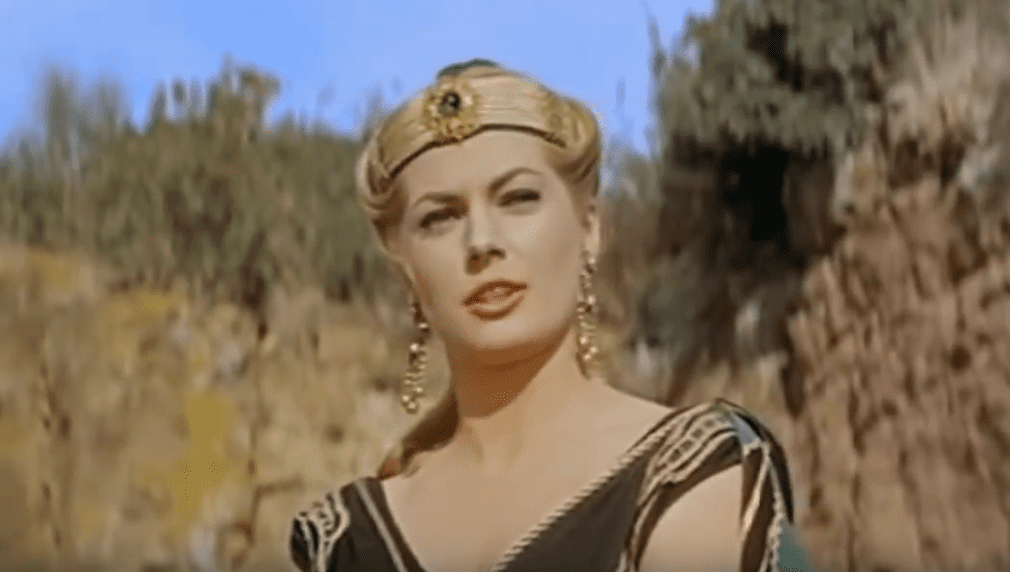History is filled with impressive female monarchs, and as far back as the third century AD, Queen Zenobia was such a ruler. Like Cleopatra so many years before her, Zenobia was a queen in the east whose power threatened Rome, and she refused to be intimidated without a hard fight. Her reign and life have been sources of inspiration for historians and storytellers alike.
Even now, she remains a legendary figure from her culture. Continue reading these regal facts About Queen Zenobia, Scourge of the Romans.
Queen Zenobia Facts:
1. Lovely Lady
Zenobia was quite the looker. According to an ancient historical source, Zenobia’s “incredible” beauty was comprised of a “dark” and “swarthy” skin tone, with black eyes that had a “powerful” expression, and teeth so white that “many thought that she had pearls in place of teeth.”
2. No, It’s Not Missing a Vowel
Much of Zenobia’s origins are hotly disputed or simply unknown by historians. It has been determined that she was born in either 240 or 241 AD. Her name at birth was Septimia Btzby.
3. Born Enigma
Zenobia’s nationality was Palmyrene. The city of Palmyra lay in what is now called Syria, and her cultural identity was a fusion of Arab and Aramean background. Unfortunately, that’s about all we can say about her ancestry, since we don’t know anything about her mother, and historians are still disputing who her father was and what his position was in Palmyrene society.
4. My Great-Great-Great-Great…
Zenobia claimed to be descended from none other than Cleopatra. According to the ancient Roman source Augustan History, not only did she claim this royal connection to the Egyptian throne, but it was true. Of course, just because the Romans said it was so doesn’t mean anything. Even if Zenobia did claim Cleopatra as a relative, she may have just embellished the truth for political reasons.
Historians have also pointed out that the Romans would have wanted to villainize Zenobia, and what better way to do that than connect her to one of their ancient foes?
5. Hear Me Roar
According to Augustan History, Zenobia adopted a traditionally masculine persona. She was an avid hunter, socialized with her generals, employed eunuchs to attend her (rather than ladies-in-waiting), rode horseback, and dressed as an emperor rather than an empress. She was even described as having a loud, masculine voice.
6. Zenny From the Block?
Zenobia has been portrayed as the daughter of commoners, but this rather romantic rise to power has been deemed unlikely by historians. For one thing, she appears to have been highly educated, which would better fit the profile of a girl born into a wealthier family.
7. The Lost History of Zenobia
One problem with learning about Zenobia is that no contemporary writings exist about her, and no contemporary statues of her have survived antiquity, either.
8. On the Flip Side of That Coin
The only physical representation of Zenobia that survived from her era is her image on ancient Palmyrene coins. Of course, while these coins certainly give an idea of what she might have looked like, we must take into account how her image could have been embellished or altered to be more flattering.
9. My Biographer
One of the primary sources on the life of Zenobia was Joannes Zonaras. Zonaras was a 12th-century chronicler who held office in the Byzantine Empire during the reign of Alexios I Komnenos.
10. I Could Have Been a Translator
Zenobia was reportedly a gifted linguist. Aside from the Palmyrene dialect of Aramaic that would have been her first language, she also allegedly spoke Latin, Egyptian, and Greek.
11. Marrying Early
Zenobia was around 14 years old when she became the second wife of a man named Odaenathus. At the time, Odaenathus was merely the lord of the city of Palmyra, but this would change eventually...
12. It’s Getting Targaryen in Here…
Considering that intermarriage between noble families was a common event in ancient history, including in Palmyra, there was a chance that Zenobia and her husband, Odaenathus, were related somehow. Of course, this is speculation rather than fact, we just thought it was worth pointing out as a (kinda gross) possibility.
13. Do Re, Me
From the 17th to the 21st centuries, no fewer than eight different operas were written about Zenobia’s life. The most recent one, titled Zenobia, was first performed in 2007, and was written by Mansour Rahbani.
14. Who’s Your Daddy?
Several names are given in history as the father of Zenobia. Among them is a man named Julius Aurelius Zenobius, an important man in Palmyra. Another name given is Antiochus. Nothing is known for sure about him, but some have speculated that Antiochus may have been descended from the kings of the Seleucid Empire, who had once ruled the territories conquered by Alexander the Great.
15. Daughter of Zabbai?
Another name associated with Zenobia was “Bat-Zabbai.” This name’s arrangement could imply that Zenobia was the daughter of a man named Zabbai. It could also mean that Zabbai was the name of a famous ancestor.
16. Mazel Tov? I Think Not
Years after Zenobia’s death, Christian scholars and historians would make the claim that Zenobia had been born Jewish and had practised that faith her entire life. This has often been dismissed, however, since no Jewish sources make any such claims about Zenobia.
17. The Context
Prior to Zenobia, the city of Palmyra had spent centuries being subordinate to the Roman Empire. This changed in 260 AD, when Emperor Valerian went to war against the Sassanid Persian Empire. The campaign resulted in Valerian's utter defeat and humiliating capture. But his misfortune was Palmyra's luck: In that moment of weakness, the city would suddenly emerge as a very important power in the east.
18. In for the Ride
In 263 AD, Zenobia was still a young woman when her husband, Odaenathus, declared himself the King of Kings. He had previously made himself the King of Palmyra, and had won a surprising series of victories against the Persians. This military success persuaded Odaenathus that he was powerful enough to carve out a real empire for himself, despite his supposed Roman allegiance.
Not only that, he crowned his eldest son (Zenobia’s stepson) as his co-ruler.
19. The Ides of Palmyra
For all the success of Zenobia’s husband, disaster struck Odaenathus in 267 AD. He and his co-ruler son were both assassinated upon their return from a military campaign. His second-oldest son was just 10 years old at the time, so his mother, Zenobia, became the ruling queen regent.
20. Obligatory Romance
Arguably the most famous opera about Zenobia’s life was the one written by famed Italian composer Gioachino Rossini: Aureliano in Palmira. Like so many operas, it depicts a dramatic love triangle between Zenobia, Roman Emperor Aurelian, and Prince Arsace of Persia. Premiering at La Scala in 1813, the work has been performed many times since then.
21. A Taste of Power
Before their reign, both Zenobia and her husband Odaenathus had close ties to the Roman Empire. At the time, the empire had been long established in the east, and Palmyra was a province associated with it. Odaenathus, however, soon weaseled his way into power under the ruling emperor's nose, effectively breaking the alliance with Rome.
Of course, that was nothing compared to what Zenobia would do when she got a crack at being the queen, and Rome soon became her great enemy...
22. English Impact
Such is the impact of Zenobia that she is directly named in one of the most famous English stories ever written. In the 14th century, Geoffrey Chaucer wrote his unfinished masterpiece The Canterbury Tales. In one of the segments, Zenobia’s life is summarized as an example of tragedy in a story told by the character known as the Monk.
Other historical figures who are named by the monk are Alexander the Great, King Croesus, and Julius Caesar.
23. Thanks, I Think
In the ancient and modern eras, Zenobia captured the interest of historians and writers. Bringing up Augustan History again, the author openly admits within the text that Zenobia’s legacy is intentionally being compared to the weak and incompetent ruler Gallienus, who was emperor at the time that the History was written. The worst accusation against him? That he was so weak he let a woman rise to power.
24. I Feel a Song Coming on
In 1977, Lebanese music star Fairuz first performed the song “Zenobia.” It was written by her regular collaborators, the Rahbani brothers. Considering that one of them was behind the 2007 opera about Zenobia (remember that?), the subject matter was certainly familiar ground for them.
25. Art Is Life
Giovanni Tiepolo was an Italian painter in the 18th century who was commissioned to make the painting Queen Zenobia Addressing Her Soldiers to decorate the walls of a palace in Venice. At the time, the palace was in possession of the wealthy Zenobio family. Before you ask, no, they weren’t related to the warrior queen, but we can certainly imagine them happily spreading that rumor while hosting dinner parties.
26. There’s a Queen on the Throne Now
When Zenobia was queen, she quickly made her authority crystal clear to any naysayers. Any Roman governors who refused to recognize her as the queen regent were confronted with the threat of her "glittering show of strength."
27. The Perfect Opportunity
Around 270 AD and now fully antagonistic toward Rome, Zenobia really showed that strength by successfully invading their territory in Egypt, which was weakened by the crumbling of the Roman state and some pesky pirates. The Queen was so convincing, in fact, that the Egyptians even defected to Zenobia’s side to help her take over.
As a result, Zenobia was officially a wanted woman in the Roman Empire.
28. Who Do You Think You Are, The Queen of Sheba?
Bible and Torah readers might remember the Queen of Sheba. This ruler appears in both Jewish and Christian holy texts as a woman who pays tribute of gifts to King Solomon. There was an attempt by Arab historians to link Zenobia with the Queen of Sheba, but any such connection is highly debatable.
29. United Palmyra
One of the strongest aspects of Zenobia’s rule was her open embracing of all cultures. Palmyra was always famous for having a diverse population, and Zenobia was only too happy to lean into that tradition of multiculturalism. Historians have speculated that this was a calculated move on her part, since you need any allies you can get when your enemy is the Roman Empire.
30. The Queen Mother
While most regents in history have tried to take power for themselves by eliminating the genuine heirs, on the surface Zenobia never pretended to be anything other than a placeholder for her young son. Her son, Vaballathus, was always recognized on Palmyrene coinage and in historical records. Still, it was helpful that Zenobia held all the real power and decision-making.
31. What’s the Truth?
Some men writing about Zenobia over the years would push the idea that she was a very chaste woman. Reportedly, she would only bed her husband to conceive a child, and otherwise avoided intercourse as much as possible. It remains unknown whether this is a genuine fact about Zenobia, or whether it was retroactively attributed to her in an era where a woman’s liberation was a scandalous idea.
32. Important Woman Inspires Important Woman
In the 19th century, two famous sculptures were made of Zenobia: “Zenobia, Queen of Palmyra" and “Zenobia in Chains.” Interestingly, both these sculptures were the work of Harriet Hosmer, widely considered to be the first woman to work as a professional sculptor in American history.
33. Does Palmyra Have a Sesame Street?
Zenobia had a very famous respect for education and knowledge. Scholars from around the world were welcomed to her court, and the Queen put an emphasis on learning in her realm.
34. Up the Ante(ioch)
Although Zenobia’s reign began in the city of Palmyra, the majority of her administration had its home base in the larger city of Antioch. Zenobia would spend much of her reign in that city.
35. She’s a Hit!
In 1997, Syrian television aired a special soap opera titled Al-Ababeed. It followed the life of Zenobia and ran for 22 episodes. Al-Ababeed was a highly successful show, with millions of people across the Arab world watching and praising it.
36. Why Burn It All When You Can Just Conquer It?
While it might have been tempting to entirely wipe out the Roman system once she took power, Zenobia was one smart cookie, and, not wanting to cause unnecessary unrest, performed no such erasure. The Roman style of administration was actually left intact under her rule, and she only really made some personnel changes.
37. Thanks, Sergio
Zenobia appears in the 1959 film Sheba and the Gladiator, starring Anita Ekberg as Zenobia. While the film was a modest success, it was one of the first films written by future famed director Sergio Leone, who would go on to turn Clint Eastwood into an icon with films like The Good, the Bad and the Ugly.
 Sheba and the Gladiator, Lux Film
Sheba and the Gladiator, Lux Film
38. That’s Our Queen
To this day, Zenobia has been embraced by the nation of Syria as a patriotic figure. Her legacy was inspiring to the Syrian nationalist movement, and she has frequently appeared on Syrian banknotes.
39. Disastrous Defeat
Zenobia ruled with an iron fist for years, but what goes up must come down—and her downfall came with the Battle of Emesa. After a stroke of bad military luck on Zenobia's part, the vengeful Roman army had been pummeling her forces for months. Nonetheless, she mustered her men and loyal subjects and amassed an army going 70,000 strong.
Tragically, it wasn't enough: she faced an immense Roman stronghold of 200,000 men. Even so, she gave them one heck of a run for their money, and her cavalry managed to defeat and scatter the skilled Roman horsemen. This brief glimpse of victory, however, soon died out, and Zenobia was forced to retreat with her army in shambles.
40. The Last Resort
Zenobia was not one to go running with her tail between her legs, and she soon travelled out of her hideout to persuade the Persian Empire to join her in an alliance. It was a fatal error: Despite riding swiftly, Zenobia was captured by the Romans, and her city surrendered soon after they found out the bad news.
41. The Sacking of Palmyra
After Zenobia was taken by the Romans, her beloved Palmyra suffered a cruel fate. The empire sacked and looted the city, killing any and all citizens in their path and destroying architecture in a bid to ensure Palmyra never rose to threaten their power again.
42. Mysterious Death
If we don’t know much about Zenobia’s origin, we know even less about her demise. No historian’s account agrees on how she died. One record states that Zenobia died while she was being taken back to Rome as a captive, while another suggests she was publicly humiliated as a part of the Emperor’s triumph against her. To rub salt in the wound, some even claim she was then beheaded after this humiliation.
43. The Good Life
More optimistic historical sources say that Zenobia was permitted to live in quiet retirement in Italy. In the case of this last idea, she was either living alone with her children, or married a distinguished Roman senator or noble.
44. Murder Most Foul
According to some sources, threatening Rome may have been the least of Zenobia's dark acts. One conspiracy theory states that Zenobia was directly involved in the assassination that felled both her husband Odaenathus and his heir—you know, the one that catapulted her into power as Queen Regent. Though she certainly gained from their deaths, we'll never know for sure if this whisper is fact or fiction.





















































